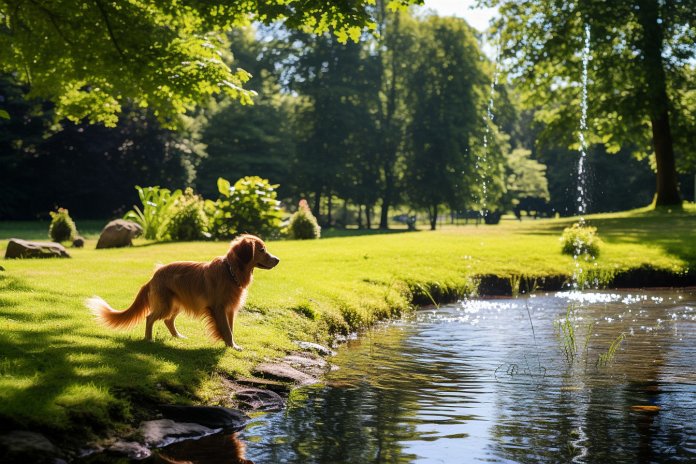
Dogs have an incredible sense of smell due to evolution, making them excellent hunters and capable of assisting humans in situations that require a heightened sense of smell. Dogs are even able to smell substances through water, which makes them valuable in investigations like finding a missing body. This article will explore how dogs with their astounding sense of smell can identify drugs and other substances in various circumstances.
Signs Dogs Can Smell in Water
When a dog smells something in the water, they will exhibit behaviors that indicate excitement. They become alert, focused on a specific area, wag their tails, and raise their ears. If a dog is swimming and detects a substance, they will circle or repeatedly return to that area. Additionally, dogs will communicate their findings to their owner through behaviors like sitting, laying down, or stopping at the site. Some dogs may even provide an audible sign if trained to do so. Even if they haven’t been specifically trained to identify a substance, dogs will still show interest in the scent they have found.
Body Language
Dogs display various signs if they discover something in the water, including barking, whining, jumping up, sniffing, and raising their ears. They may also circle an area, display trained cues, or paw at their owner to get their attention.
History Behind Dogs Smelling Drugs in Water
Dogs have always been beneficial in criminal investigations because of their ability to detect objects and substances like drugs in different materials. The use of dogs in policing became more prevalent in the 20th century, with breeds like German Shepherds being considered ideal for identifying and apprehending criminals. Over time, dogs have been trained to recognize specific scents and respond to hostile or violent behaviors. They now assist in various situations, including detecting drugs, locating explosives, search and rescue missions, supporting military personnel, and apprehending criminals in security, military, public, and airport settings.
Science Behind Dogs Smelling Drugs in Water
Dogs have a significantly stronger sense of smell than humans. They have 300 olfactory receptors compared to our 6 million, and their brain’s ability to interpret smells is 40 times more powerful. Dogs have a separate system for smelling and breathing, allowing them to analyze smells more effectively. Their sense of smell is so powerful that they can detect a tablespoon of sugar in a million gallons of water. This explains their ability to locate small amounts of drugs in water during search and rescue operations.
Training a Dog to Smell Drugs in Water
Training a dog to smell drugs in water can be a challenging and time-consuming process. The right breed of dog must be chosen, and the puppy should be trained to be obedient and responsive to commands and gestures. Positive reinforcement is used for rewards during training. The dog must also be fit, agile, confident, and free from physical ailments that could affect their performance. Play is used as a method to train dogs to identify drugs, starting with playing tug of war using a clean towel and gradually associating the smell of drugs with the game. Dogs are trained to only perform one type of search as they cannot communicate the exact substance they have detected to their handler.
“In a million gallons of water, they can smell a tablespoon of sugar.”

Tips & Things to Know
1️⃣ Dogs have an incredible sense of smell that allows them to detect scents even in water. If a dog smells something in the water, they will display alert behaviors such as wagging their tail, raising their ears, and circling the area. They may also exhibit behaviors like barking, whining, or pawing to get your attention.
2️⃣ Certain breeds of dogs, such as German Shepherds, Basset Hounds, Beagles, and Bloodhounds, are naturally better at detecting smells. These breeds are often used as security or police dogs because of their superior olfactory abilities.
3️⃣ Dogs can be trained to smell drugs in water, but it is a challenging and lengthy process. The training involves selecting the right breed of dog, making them obedient, and teaching them to associate a specific smell with a game of tug of war. It is important to note that each dog can only perform one type of search and cannot communicate the exact substance they have detected to their handler.
Frequently Asked Questions, Answered ✅
1. How can dogs smell substances in water?
Answer: Dogs have a highly sensitive sense of smell that allows them to detect scents even through different materials, including water.
2. What are some signs that indicate a dog has detected something in the water?
Answer: Signs that a dog has detected something in the water include being alert and focused on a specific area, wagging their tail, raising their ears, circling the area or returning to it, and displaying behaviors such as sitting or stopping at the site.
3. Which dog breeds are naturally better at detecting smells?
Answer: German Shepherds, Basset Hounds, Beagles, and Bloodhounds are breeds that are known for their superior sense of smell and are often used as security or police dogs.
4. What is the history behind dogs being used to detect drugs in water?
Answer: Dogs have been used in criminal investigations since the time of the Jack the Ripper case. Countries like Germany, Austria, Belgium, and France developed methods that utilized dogs’ smelling abilities, and German Shepherds became especially renowned for their effectiveness in identifying and apprehending criminals.
5. How do dogs’ sense of smell compare to that of humans?
Answer: Dogs have 300 olfactory receptors in their nose, compared to the 6 million that humans have. The part of a dog’s brain that interprets smells is 40 times stronger than in humans. Additionally, dogs have a separate system for smelling, allowing them to analyze scents more effectively than humans.